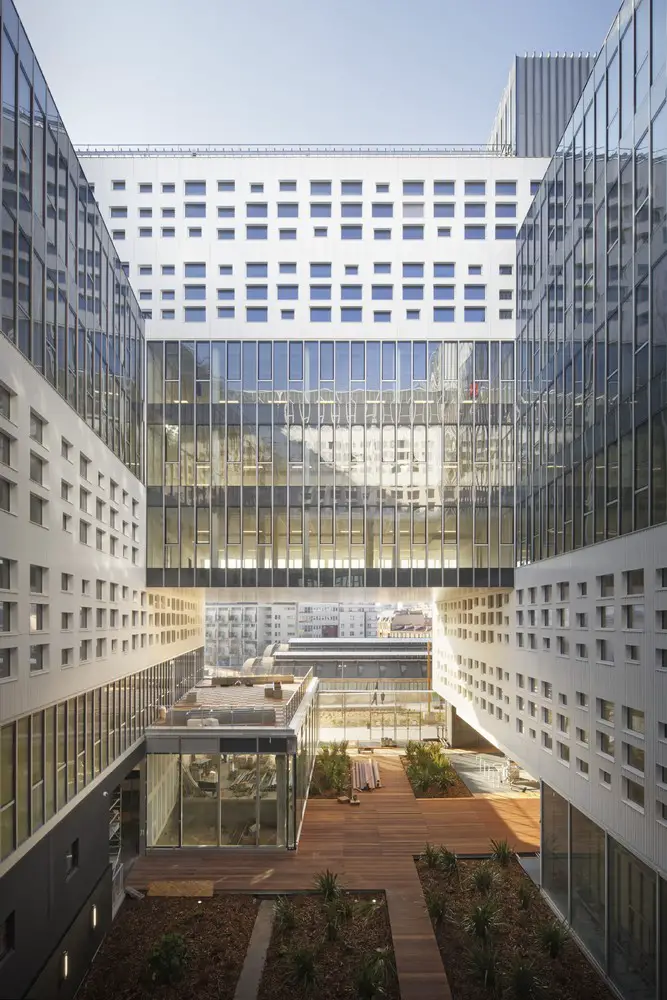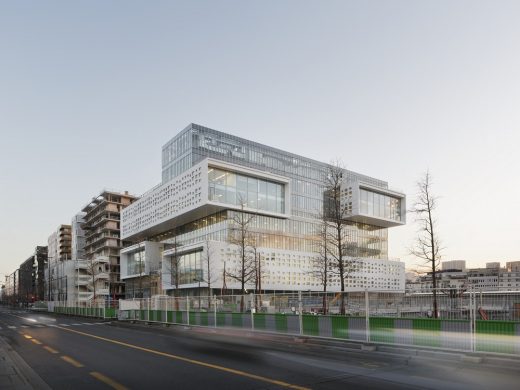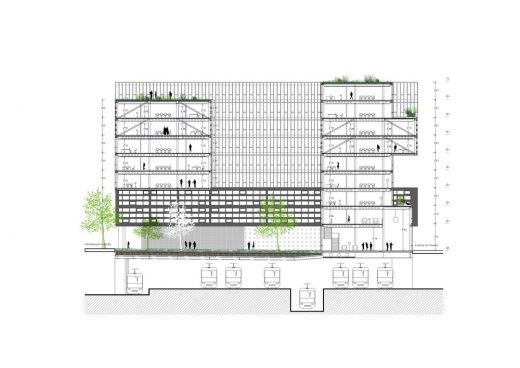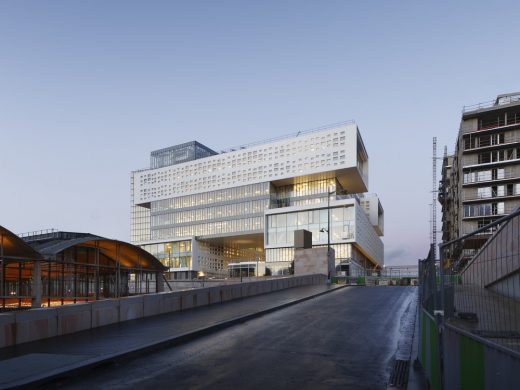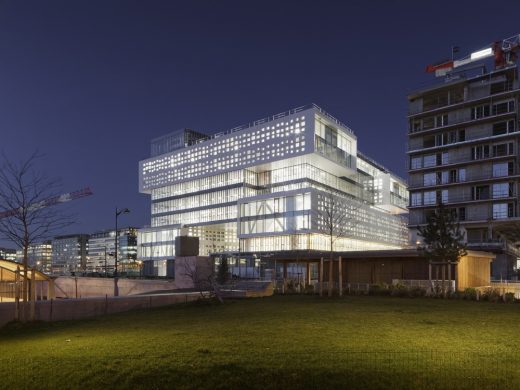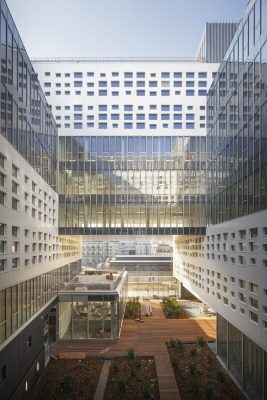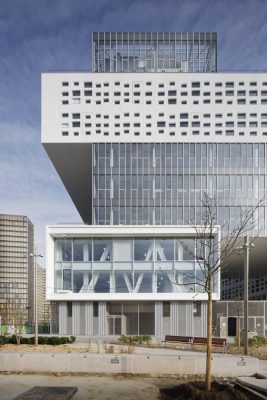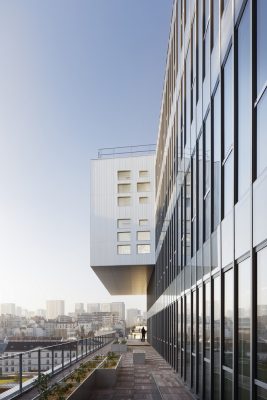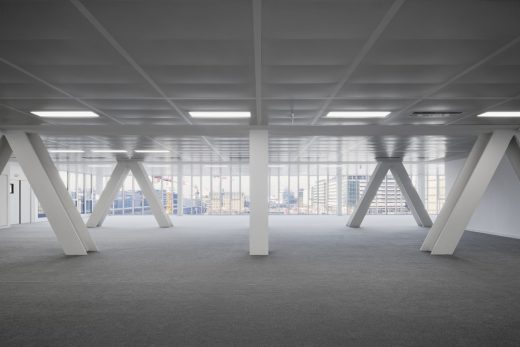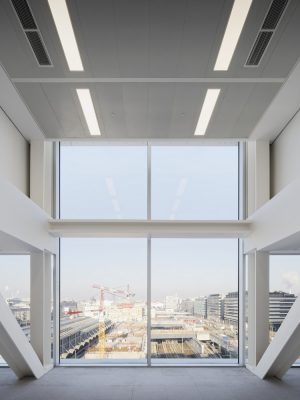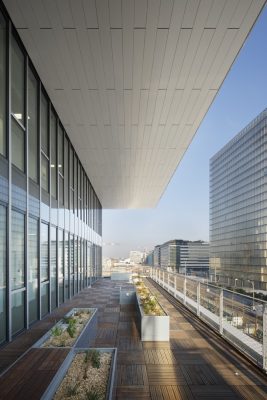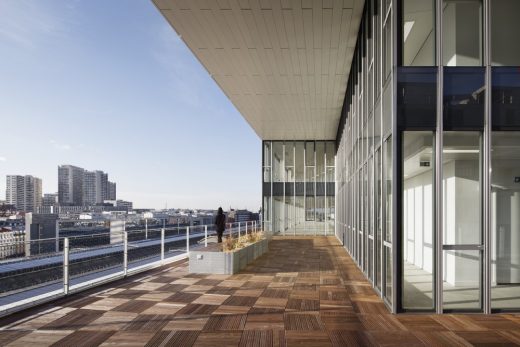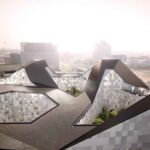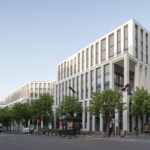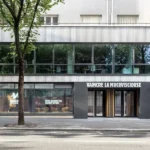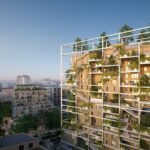Panorama Bridge-Building, Contemporary Parisian Office Building, French Architecture Images
Panorama Bridge-Building in Paris
Modern Office Building Project in Paris design by Marc Mimram Architecture, France
26 Mar 2019
Panorama Bridge-Building
Design: Marc Mimram Architecture
Location: Paris, France
Panorama Bridge-Building News
Flowing like a river between the Avenue de France and Halle Freyssinet are the railway lines, now wider, now merging together. Here, to the right of the Panorama building, the possible area without intermediate supports is 58 meters (190 feet).
Everywhere else, the buildings being erected over the railway network have been constructed on a thick platform, a table of concrete on which any collection of buildings conforming to the rules of urban development can be erected at random without planning ahead of time.
Urban planners have abandoned the idea of the tabula rasa in favor of a tabula nova : a platform waiting to be developed. This approach is irrational and wasteful. Furthermore, it cannot be transposed to the right of the project because the span is too great, intermediate supports only being possible if a costly reconstruction of the rail infrastructure were to be undertaken. Marc Mimram Architecture’s proposal approaches the problem from the other end. Instead of installing an initial platform, they have suggested suspending the platform forming the roof over the rails from the bridging building.
This new theory changes the economic equation, allowing the cost of the invisible platform structure to be integrated with that of the superstructure of the building, this particular geographical arrangement allowing for a different kind of architecture. As designed, the building thus becomes a bridge-building resting on either side of the tracks, which are 58 meters apart, its 16,000 tons being suspended above the trains. The effect of this structural arrangement is liberating, making it possible to make particular use of gravitational stresses. Since the stresses are concentrated in the floors forming the bridging structure, the other parts of the building are free.
Suspended from or resting on the main structure, they can vary in thickness and embrace elements such as terraces, balconies, loggias, or mezzanines all different ways of expanding the working space depending on orientations and views. This choice of structural design makes it possible to develop comfortable tertiary spaces.
The different areas and spaces extending from the office areas open onto the city or are screened from it by the use of corbelling. The working areas are able to enjoy these extensions, whether shared or individually acquired. Paradoxically, these very generous arrangements are the result of the structural constraints of the bridge design and the resolving of the problem of the railway lines by integrating the roof over the tracks into the design rather than using an inefficient supporting platform that would only increase the overall cost of the project.
The architecture gains in coherence and the structure itself is implied without drawing attention to itself. The railway lines below will disappear along with the whole network beneath the new construction, but the extraordinary method used will continue to evoke their presence. The beams of the main bridging are concentrated in the floors with façades pierced with a pattern recalling the Vierendeel beams used. The terraces included on the suspended or supported floors are freely varied.
Both the memory of the fabrication process and that of the work site are embodied in an architecture that does not necessarily flaunt its muscles but which reveals itself without camouflage, without concealing its initial determining geographical condition. The project sprang from this coherent view; its realization becomes architecture.
Regaining The Urban Horizon
The tertiary project developed between the Bibliothèque de France and Halle Freyssinet crosses the railway lines. This is not to say, however, that it should ignore the urban landscape to which it belongs quite the opposite. In our view, the bridge formed by the project anchors it in its surroundings in the 13th arondissement, a magnificent geographical and constructed topography extending from the towers of Porte d’Italie on the horizon towards Butte aux Cailles, between the Gobelins and La Salpêtrière, and, in the distance, Ivry and Gentilly. All these places can be seen exceptionally well from the building, entering into a dialogue with it and establishing its architecture: in exchange, we offer this panorama.
The project occupies a very specific place in the development of the Paris Rive Gauche area, and particularly along the Avenue de France. To the north-east, it looks over the towers of the Bibliothèque de France, towards the Parc de Bercy, on an axis with the footbridge over the Seine. This link is particularly significant because it marks a slope in the ground here and anchors the new Rive Gauche over the roads of the 13th arondissement of the past.
Taking the constraints of the bridge-like structure as a starting point, the project aims to create new conditions of use of a tertiary building. It is the intention to enter into a dialogue with the city in relation to these new conditions of use. Marc Mimram Architecture’s structural and morphological research has been guided by these considerations.
The project seeks to take advantage of its exceptional structure more work of art than building in order to generate in turn exceptional situations. The structure required to bridge the railway lines gives great freedom of form to the envelope and, given the specific opportunities of the site and the views it offers, allows it to include places of use directed at the surrounding urban landscape: continuous balconies, double height spaces, terraces, and framed views.
The Environment As A Condition Of Use
Marc Mimram Architecture would like to see dialogue with the city as a central feature of the development of the project. The situation of being able to see out is echoed by the possibility of being seen. The building standing here is not just in alignment with others, it is also part of a remarkable perspective.
The city, the horizon, the sky, and also lights and orientations are all environmental conditions, and we want these to guide the new tertiary uses put forward by the project. The specific situation of a bridge-building makes it possible to create structures separate from the spanning elements, great bridging beams spanning 58 meters, suspended and supported elements.
Thanks to the difference of these elements from the larger structures, terraces, double height spaces, and loggias can be inserted between the structural elements. Tertiary occupation can move away from its geometrical logic (1.35 meters (4.4 feet) long by 18 meters (59 feet) wide, with an unlit central section) to discover new dimensions, varying from 6 to 19 meters (9.6 to 62.3 feet) wide, dual aspect offices, and free levels with different façades or external extensions.
It is Marc Mimram Architecture’s aim to reconsider the conditions and take advantage of the freedom offered by structures such as this to create new conditions of work in the tertiary sector. The world of offices has become too rule -bound. Here we have an opportunity to innovate, offering a variety of new, adaptable, and differentiated ways of working.
Moving away from the traditional style of office, here we can create work places that open out on to the city, extended by shared spaces, horizontal spaces for socializing such as the covered terraces, or vertical balconies in the form of mezzanines. Marc Mimram Architecture’s project opens the way and encourages new styles of working in the tertiary sector, promoting conviviality in the workplace and putting in place arrangements that bring people together under the best possible conditions.
The building makes use of the constraints imposed by its bridging structure to create variations in usage. The environmental quality here is derived from the different uses, orientations, and openings on to the city horizon. The project develops and takes shape in line with the possibilities offered by the structure for its orientation in the urban landscape.
Panorama Bridge-Building, Paris – Building Information
Project Supervisor: Marc Mimram Architecture & Associés
Partners: Marc Mimram Ingénierie : structure et economy, Edeis : fluid, VSA : facades, Greenaffair : environment, Léopold Fauconnet: interior designer, Franck Neau : landscaper, Base : landscaper
Project team Marc Mimram Architecture Ingénierie : Guillaume André, Emilie Ballu, Maxime Lefranc, Jacques Durst, Denis Muet, Sergio Pauletto
Client: ICADE Investor: AG2R LA MONDIALE MATMUT, via sa foncière AGLM immo
Construction Firms: Victor Buyck : metal frame, Prologis : essential structural, Rinaldi Structal : facades, Ogim : roofing/waterproofing, Vinci énergie : electricity-plumbing, MRG : equipments-hoods, S.N Falleau : green space, Spie Batignolles : architectural interior works, Alma : drywalls, TSM : locksmith / metal work, Thyssenkrupp : elevators
Cost of the Construction: 50 M€
Planning: winner of the competition in 2012 – beginning of the construction in 2014 – project delivery in 2019
Areas: 16 000 sqm – 15 000 sqm – offices and 1 000 sqm – shops
Key Data: 58 meters span – 6000 tonnes of steel
Photography © Camille Gharbi
Panorama Bridge-Building in Paris images / information received 260319
Location: Paris, France
New Paris Architecture
Contemporary Paris Architecture
Paris Architecture Design – chronological list
Architecture Tours in Paris by e-architect
, France
Architecture: Agence Patrick Mauger
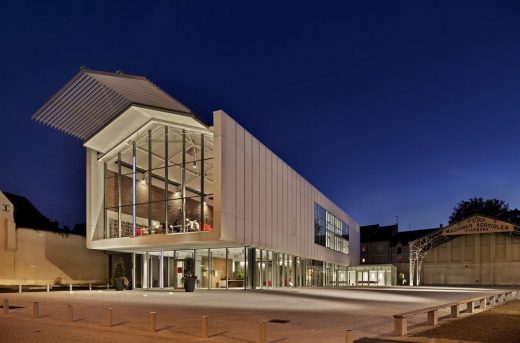
photo : Michel Denancé
Auneau Cultural Center
, Les Ateliers Gaité, 14th arrondissement
Architects: MVRDV
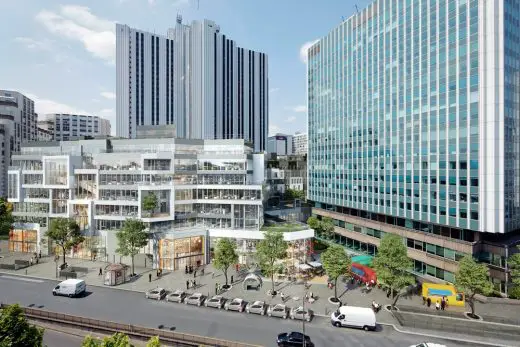
image © L’Autre Image
Gaité Montparnasse
Design: AZC Atelier Zündel Cristea, Architects
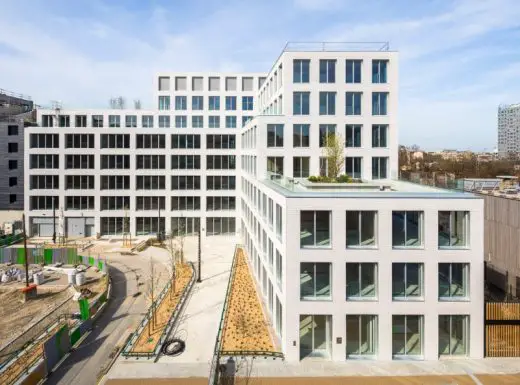
photo courtesy of architects office
Hôtel d’entreprises Binet
, Lagravère Park, Colombes, northwestern suburbs of Paris, France
Design: h2o architectes
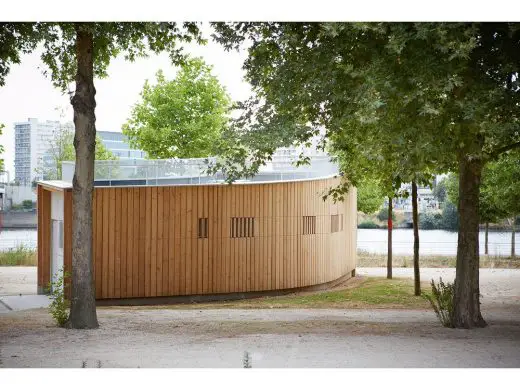
photo : Julien Attard
River Seine Park Pavilions
Paris Architecture – Selection
Comments / photos for the Panorama Bridge-Building in Paris page welcome

